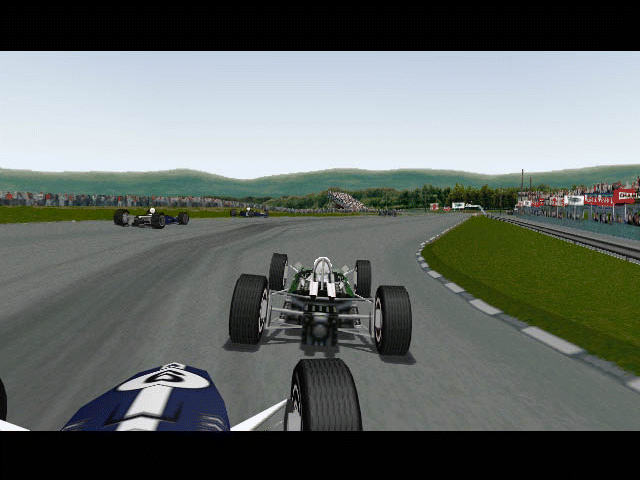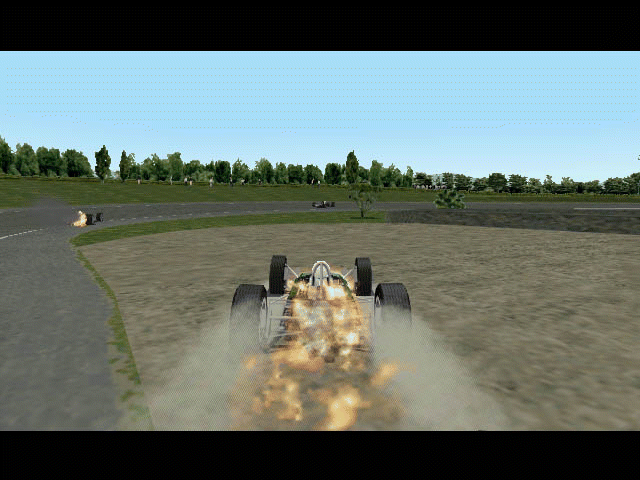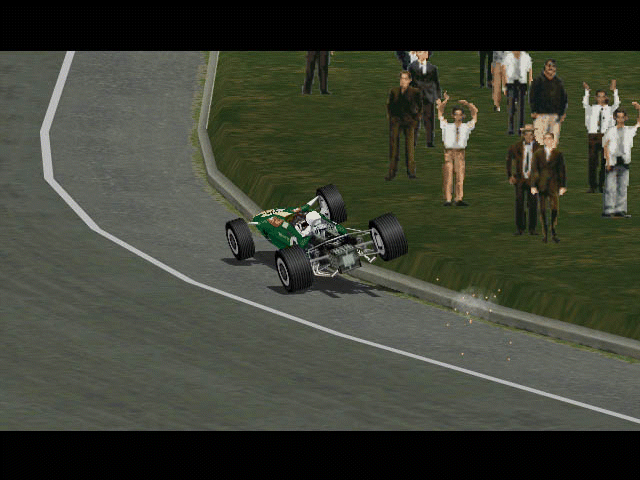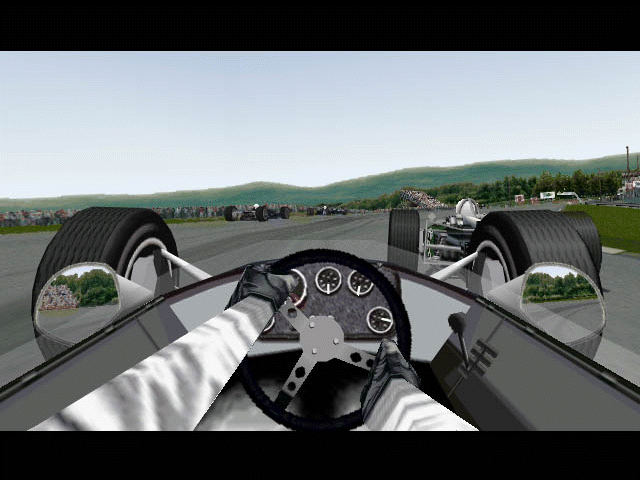Why I loved hardcore racing sim Grand Prix Legends
The story of the racing sim that wouldn’t die.

That man was Gianluca Branchesi. He managed to reverse the machine code in the game executable and uncover the secrets of Grand Prix Legends. It was the Rosetta Stone of driving simulator code. He who controlled the code could unlock and master the Grand Prix Legends universe... if that’s what he wanted. Ginaluca didn’t, but he did find a table that linked engine type with chassis type. This was the meddlers’ Holy Grail. After discovery, this table passed along a chain of methodical head-scratchers who specified and refined the patterns, until it eventually fell into the laps of software and Grand Prix Legends buffs: Richard Nunn and Paul Thurston.
Now, it’s simple logic that a significant advantage can be gained by splicing the engine of a more powerful car into a lighter chassis. Nunn and Thurston understood the possibilities and the repercussions. Inquisitiveness won and Thurston created ‘GEM’ engine modification software that enabled a Grand Prix Legends user to swap engines and chassis in the game’s front end. A workshop for cheats. “Shall we release this?” asked Thurston. They did.
It caused a scandal. The purity of the sport had been sullied. The unhackable had been ‘back-doored’ by curious coders.
“I did receive death threats,” admits Thurston. Concerned though not overly alarmed, Thurston managed to electronically track the perpetrator and acquire his phone number. The criminal was twelve years old. Words were exchanged with his mum and feuds continued within the community. Rather than turning corners, people turned backs.
Too late to close Pandora’s Box, engine swapping became accepted as honest customisation (so long as you were honest when using it) and new online classes developed: Formula Libre (any car—any chassis), FG (F1 car—small F3 engine) and so on. Fury and outrage was usurped by the wail of swapped engine noise.

Grand Prix Legends had changed. Limits were meaningless when users could play with the fabric of the game. Thousands of variants mutated the pedigree racing stock, but the power of change meant nothing without control.
Individual customisation wasn’t considered to be within the spirit of the game but somehow creating a whole new racing season was. The lunatics were taking over the asylum and painting it a better colour. They set out to reinvent the wheel, right down to the wheel nuts. Nuts.
The biggest gaming news, reviews and hardware deals
Keep up to date with the most important stories and the best deals, as picked by the PC Gamer team.
But which year should the Grand Prix Legends time machine visit? How far should the new development team go? The time lever couldn’t move past 1967 because in 1968 Lotus engineers stuck clumsy planks above their car and called them ‘wings’. Wings created aerodynamic downforce and changed Formula One forever, but as they didn’t exist in 1967, the code for wings didn’t exist in Grand Prix Legends.
The time lever could only move backwards. 1955 was proposed—the golden days of Stirling Moss and five-time World Champion Juan-Manuel Fangio. A period when three-quarters of the car was a front engine and the driver sat at the back, behind a hula-hoop sized steering wheel, almost as though driving from the boot. 1955 could be done but was far removed from the 1967 rear-engined models laid down in Grand Prix Legends.
It was decided to take the time machine on a shorter hop, back to 1965. The Vietnam War was starting, The Beatles had released Rubber Soul and Formula One cars weren’t a million miles mechanically from their 1967 progenies, although their engine capacities were. 1.5 litres compared to 1967’s unruly 3 litre bomb-in-the-boot.

The community harnessed the code and set about making ‘Grand Prix Legends of 1965’. The level of detail and research required by this amateur team still astonishes and would humble the works of many a professional game developer. Their obsession and passion epitomised in this excerpt from an interview with racing legend and Mini Cooper deity, John Cooper: “Were the pedals bottom or top hinged?” “They were always bottom hinged.”
Straying from the brief of total simulation to game would violate the stubborn doctrine of Grand Prix Legends. Nothing but reality was the ethos. We weren’t being fed some lowest common denominator product of car licences and a face full of marketing hype. Reality is much harder than videogames—harder to play and harder to sell.
Over the next three years a cast of hundreds threw their weight into the project. They lurked, with cameras, tape measures and reporter’s notebooks at historic car shows. Racing drivers were consulted. One contributor, Arturo Perreira, gained access to the Argentinean Automobile Club in Buenos Aires to absorb its complete library, including nearly 1,000 back-issues of Motorsport magazine, searching for relevant references.
Understand dedication. Understand the 1965 team.
Resources were pooled from around the world. A texture here, some tyre data there; it trickled in. Methodically, religiously compiled data was fed into computers and moulded into new playable versions of Grand Prix Legends. Beta versions were distributed to a select band of testers and their opinions and suggestions were irrigated back and the process repeated: “The same, but better” each time, for nearly three years, until one day somebody said “Stop”. It was over. It was 1965 again.
We were now playing ‘Yellow Submarine’ on our violins.

The result: arguably the most meticulous but remorselessly unforgiving driving software ever released has finally become accessible to all-comers. The beast now plays with you instead of consuming and spitting you out. Visually there isn’t a world of difference. The same tracks are used but the car models are smaller and sleeker. But you’ll understand the difference two years of Formula One makes when you’re clumsy with the throttle mid-corner and don’t immediately hit a tree, another car or end up facing backwards.
It was the nature—not the execution—of the original simulation that offended the general public. By reducing the engine power and tickling the physics, the ethos has been retained but the frustration has been drained. The same laws of nature apply, but you can influence the outcome now. You can even have fun.
25,000 have downloaded so far, which is a considerable percentage of the original audience—six years later.
Hindsight reveals the original Grand Prix Legends was overly ambitious for the mass market. You might as well simulate a hanging from the victim’s point of view.
Even the original Grand Prix Legends designer David Kaemmer said: “Maybe we blew it with choosing 1967.”
History would probably say that you did blow it, David. But your subjects stole it back and forged something more beautiful while your head was turned.
So after years of mastering this motor racing violin, a sweet harmonious orchestration finally plays. We’ve come so far from caterwauling in our bedrooms six years ago; we’ve travelled the race tracks of the world; we’ve travelled time; we’ve killed ourselves and every driver in the field a thousand times. That is Grand Prix Legends. Six years on and there’s still juice in the tank.—Dylan Davies
With thanks to the entire RSC community, Paul Thurston, Arturo Perreira, Cuthbert Hicks, Errol Williams, and Sam Singlewood.
Tracks of my gears
Grand Prix Legends came packaged with the eleven tracks that comprised the 1967 season—bar a boring Le Mans in-field race that was replaced by the lavish, visceral road course at Rouen. The exhausting 14 mile, 174-corner Nurburgring was the most alluring course. A legendary, monstrous, zig-zag loop forged from the Eiffel Mountains of Germany. It is still used as a test ground for auto manufacturers today. There is also the original Belgian Grand Prix course which is a full five miles longer than its modern incarnation and ten-times more dangerous. Formula One was different back then.
The encyclopaedic vision of Grand Prix Legends enables you to see how it was. Driving these roads and making a mistake that would kill you, makes you understand how Formula One could kill you. Hundreds of new tracks have been made. Chronologically correct versions of dead tracks and forgotten amphitheatres that defined modern motorsport. New tracks are created almost on a monthly basis and each one is a whole new game in itself. That is why Grand Prix Legends is still a vibrant game today. A track database can be found here.

Recommended fan tracks
Isle of Man: The TT motorcycle course recreated for virtual Formula One. Technological constraints limit it to only 15 miles of the whole course—but it works so well. This mammoth track was created by one man over two years—and amazingly, he’s based in Australia.
Oulton Park: The Cheshire Grand Prix, but you won’t find a fox hunt in sight here, just a classic British track with an almighty banked hairpin thrown in for fun.
Monaco Rocks!: Ignore the name, this is the original Monaco circuit. Graphical tweaks over the years have added extra buildings, textures, and advertising hoardings to make the game a moving snapshot of Monaco in 1967. It remains the greatest representation of Monaco ever seen on the hi-res screen.
Monza 10K: The Monza we know and love today was not the Monza of 1966. Back then it had a banked in-field to add to the 200mph straights. A true, cheek-clenching wall of death that wore down your throttle leg as you ‘floored it’ for around 90% of the six-mile circuit. With extra crowds and hoardings from the day, it’s one of the most atmospheric Monza efforts in F1 games.
Solitude: A fast paced undulating German track. A great example from a time when races were run on seven miles of country roads, lined not with Armco but with big trees that collected drivers in their branches.
What you need to play GPL today
- A 1GHz or better PC with Direct 3D/OpenGL graphics card. All modern cards will meet this requirement.
- A force feedback steering wheel and pedals. (You can use non-force feedback, but you’ll loose 80% of your, well, feedback, meaning you’ll lose 80% of the control.)
- One original copy of Grand Prix Legends.
- A large pinch of patience.
Niche simulators created twenty years ago are obviously hard to come by on the shelves of your local shop, and asking the assistant may provoke confusion or sarcastic face-pulling. The problem is solved by typing “Grand Prix Legends buy” into Google. You should be able to buy a copy online for around a tenner. That’s just two pints-worth in exchange for years of videogaming pleasure.
But like old trousers, a twenty-year old game needs some serious patching (it was originally designed for Windows 95, 3dfx cards, 333MHz CPUs and no force-feedback on the steering wheel), so the developers Papyrus released patches to cope with faster machines, OpenGL and force feedback. Since then, the community has taken up the slack—you can find the latest updates on this GPL fansite.
Install the original game, then patch it like a geeky seamstress. Hopefully, if everything is installed properly and the wind is blowing in the right direction, you should now be playing Grand Prix Legends 1967.
Most Popular


